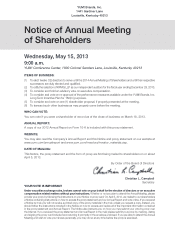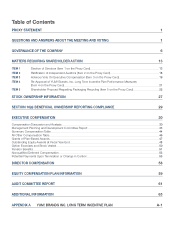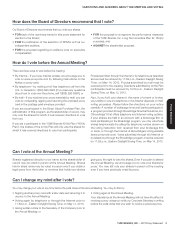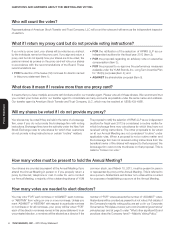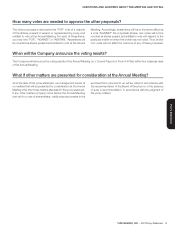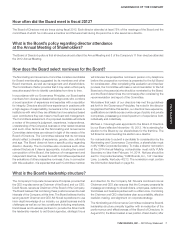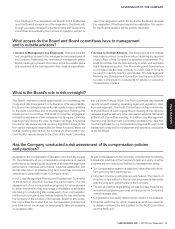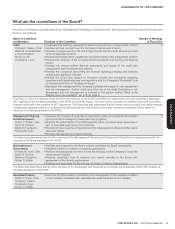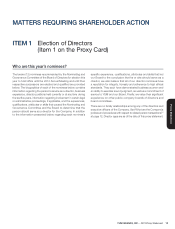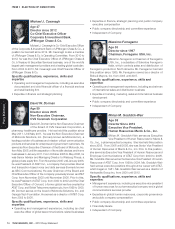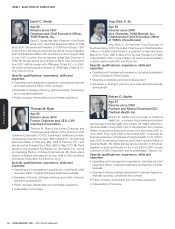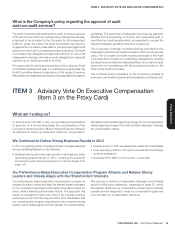Pizza Hut 2012 Annual Report Download - page 27
Download and view the complete annual report
Please find page 27 of the 2012 Pizza Hut annual report below. You can navigate through the pages in the report by either clicking on the pages listed below, or by using the keyword search tool below to find specific information within the annual report.
YUM! BRANDS, INC.-2013Proxy Statement 9
Proxy Statement
GOVERNANCE OF THE COMPANY
from the Board. The resignation will specify that it is effective
upon the Board’s acceptance of the resignation. The Board will,
through a process managed by the Nominating and Governance
Committee and excluding the nominee in question, accept or
reject the resignation within 90days after the Board receives
the resignation. If the Board rejects the resignation, the reason
for the Board’s decision will be publicly disclosed.
What access do the Board and Board committees have to m anagement
and to o utside a dvisors?
•Access to Management and Employees. Directors have full
and unrestricted access to the management and employees of
the Company. Additionally, key members of management attend
Board meetings to present information about the results, plans
and operations of the business within their areas of responsibility.
•
Access to Outside Advisors. The Board and its committees
may retain counsel or consultants without obtaining the approval
of any offi cer of the Company in advance or otherwise. The
Audit Committee has the sole authority to retain and terminate
the independent auditor. The Nominating and Governance
Committee has the sole authority to retain search fi rms to
be used to identify director candidates. The Management
Planning and Development Committee has the sole authority
to retain compensation consultants for advice on executive
compensation matters.
What is the Board’s role in risk oversight?
The Board maintains overall responsibility for overseeing the
Company’s risk management. In furtherance of its responsibility,
the Board has delegated specifi c risk-related responsibilities
to the Audit Committee and to the Management Planning and
Development Committee. The Audit Committee engages in
substantive discussions of risk management at its regular committee
meetings held during the year. At these meetings, it receives
functional risk review reports covering signifi cant areas of risk
from senior managers responsible for these functional areas, as
well as receiving reports from the Company’s Chief Auditor. Our
Chief Auditor reports directly to the Chair of the Audit Committee
and our Chief Financial Offi cer. The Audit Committee also receives
reports at each meeting regarding legal and regulatory risks
from management. The Audit Committee provides a summary
to the full Board at each regular Board meeting of the risk area
reviewed together with any other risk related subjects discussed
at the Audit Committee meeting. In addition, our Management
Planning and Development Committee considers the risks that
may be implicated by our compensation programs through a risk
assessment conducted by management and reports its conclusions
to the full Board.
Has the Company conducted a risk assessment of its compensation policies
and practices?
As stated in the Compensation Discussion and Analysis at page
33 , the philosophy of our compensation programs is to reward
performance by designing pay programs at all levels that align team
performance, individual performance, customer satisfaction and
shareholder return, emphasize long-term incentives and require
executives to personally invest in Company stock.
In 2013, the Management Planning and Development Committee
of the Board of Directors oversaw the performance of a risk
assessment of our compensation programs for all employees
to determine whether they encourage unnecessary or excessive
risk taking. In conducting this review, each of our compensation
practices and programs was reviewed against the key risks facing
the Company in the conduct of its business. Based on this review,
the Committee concluded that our compensation policies and
practices do not encourage our employees to take unnecessary
or excessive risks.
As part of this assessment, the Committee concluded that the following
policies and practices of the Company’s cash and equity incentive
programs serve to reduce the likelihood of excessive risk taking:
•Our compensation system is balanced, rewarding both short -
term and long- term performance.
•
Long- term Company performance is emphasized. The majority of
incentive compensation for the top level employees is associated
with the long term performance of the Company.
•
The annual incentive target setting process is closely linked to the
annual fi nancial planning process and supports the Company’s
overall strategic plan.
•
Compensation is primarily determined by results of the business.
•
Financial performance, which determines employee rewards,
is closely monitored by and certifi ed by the Audit Committee
and the full Board.


